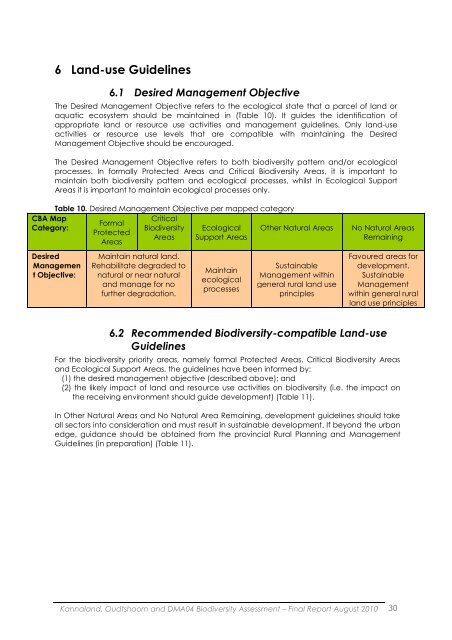Little Karoo Biodiversity Assessment - Biodiversity GIS - SANBI
Little Karoo Biodiversity Assessment - Biodiversity GIS - SANBI
Little Karoo Biodiversity Assessment - Biodiversity GIS - SANBI
Create successful ePaper yourself
Turn your PDF publications into a flip-book with our unique Google optimized e-Paper software.
6 Land-use Guidelines6.1 Desired Management ObjectiveThe Desired Management Objective refers to the ecological state that a parcel of land oraquatic ecosystem should be maintained in (Table 10). It guides the identification ofappropriate land or resource use activities and management guidelines. Only land-useactivities or resource use levels that are compatible with maintaining the DesiredManagement Objective should be encouraged.The Desired Management Objective refers to both biodiversity pattern and/or ecologicalprocesses. In formally Protected Areas and Critical <strong>Biodiversity</strong> Areas, it is important tomaintain both biodiversity pattern and ecological processes, whilst in Ecological SupportAreas it is important to maintain ecological processes only.Table 10. Desired Management Objective per mapped categoryCBA MapCriticalFormalCategory:<strong>Biodiversity</strong> Ecological Other Natural AreasProtectedAreas Support AreasAreasDesiredManagement Objective:Maintain natural land.Rehabilitate degraded tonatural or near naturaland manage for nofurther degradation.MaintainecologicalprocessesSustainableManagement withingeneral rural land useprinciplesNo Natural AreasRemainingFavoured areas fordevelopment.SustainableManagementwithin general ruralland use principles6.2 Recommended <strong>Biodiversity</strong>-compatible Land-useGuidelinesFor the biodiversity priority areas, namely formal Protected Areas, Critical <strong>Biodiversity</strong> Areasand Ecological Support Areas, the guidelines have been informed by:(1) the desired management objective (described above); and(2) the likely impact of land and resource use activities on biodiversity (i.e. the impact onthe receiving environment should guide development) (Table 11).In Other Natural Areas and No Natural Area Remaining, development guidelines should takeall sectors into consideration and must result in sustainable development. If beyond the urbanedge, guidance should be obtained from the provincial Rural Planning and ManagementGuidelines (in preparation) (Table 11).Kannaland, Oudtshoorn and DMA04 <strong>Biodiversity</strong> <strong>Assessment</strong> – Final Report August 2010 30
















